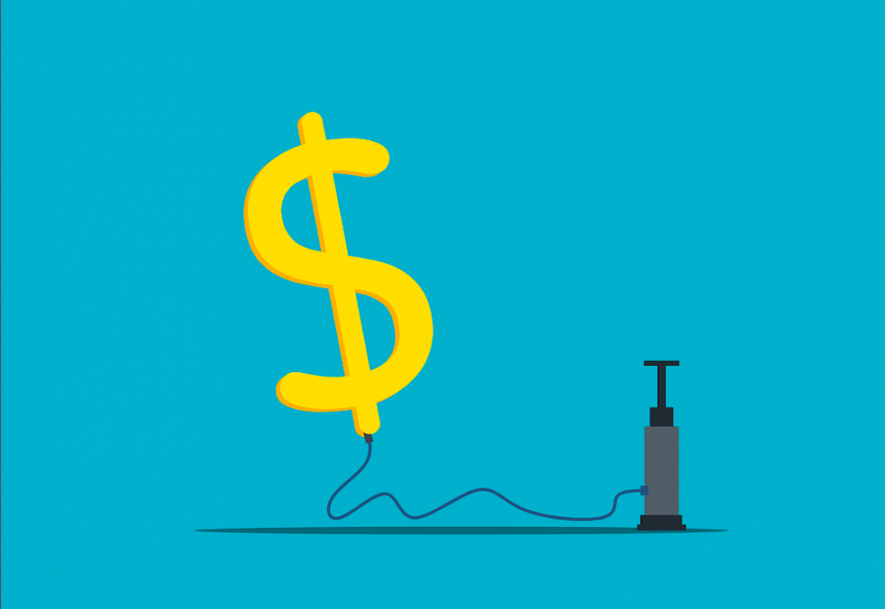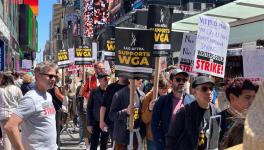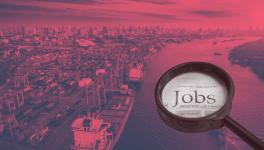There Are Better Ways to Address Inflation Than by Hiking Interest Rates

A deafening silence defines “debates” among US leaders about stopping or slowing today’s inflation. Alternatives to the Federal Reserve’s raising of interest rates and curtailing money supply growth are ignored. It’s as if there were no other ways to rein in price increases except to add more interest costs to the already excess debts of workers and small and medium businesses. Were the last two and a half years of the deadly COVID-19 pandemic plus the economic crash of 2020 not sufficient enough burdens on Americans without piling on the additional burden of inflation that has been imposed by US capitalism?
As usual, the profit-driven concerns of big business and their result—a remarkably selective historical amnesia—fuel the silence about alternative anti-inflation policies. So too do the Right-wing ideological blinders that now constrict US politics. Yet, policy alternatives always exist, no matter how desperately partisans promoting one policy seek to obliterate debate and discussion of others. The narrow dogmatism of US politics these days is on full display around the issue of an anti-inflation policy focused on raising interest rates.
I will present three other anti-inflation policies that do not entail interest rate increases—there are many more—that could and should be part of today’s policy discussions. All have precedents in US history. For the first, we return briefly to World War II. US President Franklin Delano Roosevelt’s administration grasped the risk of inflation during this period as the supply of many consumer goods shrank relative to the demand for them. The war effort was diverting many productive resources away from consumer goods and toward munitions and other defence products. Had the government allowed the market to handle the prospective shortage of consumer goods, an inflation of their prices would have resulted. Rich Americans would have bid up the prices of scarce consumer goods, rendering them unaffordable for middle- and lower-income people. That is how markets work. They favour the rich (who return the favour by funding economists and others to promote markets as marvels of “efficiency”).
For Roosevelt’s government, the war effort required a national unity that the market threatened to replace with bitterness, envy, and division, pitting the poor and the middle class against the rich. The US government thus substituted rationing for the market mechanism. It printed ration books containing ration stamps and distributed them across the US population. Rationed goods could only be sold to those with ration stamps.
No small irony (at least for those familiar with Marxism and socialism) attaches to the following: 1) the US government distributed ration books according to people’s needs, and 2) the US government’s explicit goal was to render the distribution of rationed goods (and especially food) “more fairly” than what the market would have done. Rationing forestalled the looming inflation. It could work equally well now to slow or stop inflation.
Another anti-inflation policy, other than raising interest rates, came in August 1971, from Republican President Richard M. Nixon. Responding to serious inflation, Nixon declared a 90-day “wage-price freeze.” He and his advisers knew that U.S. wage and price controls had also been deployed during World War II. Some had even read John Kenneth Galbraith’s 1952 book, A Theory of Price Control, which showed how well such controls had worked during the war.
As a result of Nixon’s action, employers on one side and employees on the other were formally denied the right to raise prices or wages, respectively. Any move to the contrary was seen as a criminal act, rendering the perpetrator subject to police arrest. In response to these measures, the inflation shrank, the stock market rose, and Nixon was re-elected in 1972. For him, the policy worked. Other countries have also imposed wage-price freezes to similar effects.
Each alternative policy to control inflation (raising interest rates included) has its particular strengths and weaknesses, virtues and flaws. Honest discussions of how to respond to inflation would involve comparing the strengths and weaknesses of all—or at least many different—policy options. Honest national leaders would not pretend only one policy exists. That approach—dominant in the United States today—yields both policy mistakes and leads to crucial opportunities being lost. It does, however, serve the interests of those who advocate for that one policy.
There is a third alternative policy to controlling inflation as an inherent risk recurringly faced by a private enterprise capitalist system. If profit is the “bottom line,” if the system’s mantra is “charge whatever the market will bear,” and if rewards and punishments follow the rise and fall of profits that depend on prices, we can hardly be surprised when capitalists raise prices. Nor can we be surprised that when they do it, it both provokes and excuses others following suit. Inflation results from private capitalists’ pricing decisions. They are driven chiefly by their private profit calculations; they need not and do not generally take into account those decisions’ larger consequences (social as well as economic) such as inflation.
The socialisation of private capitalist enterprises is thus another anti-inflation policy. A government, for example, will generally consider the inflationary consequences of any set of price increases. On that basis, it can either limit or reject them. To the extent that the government is held accountable politically for inflation and its effects, it has an incentive to control them. The Fed is, at best, held accountable only indirectly. That helps explain why the Fed has repeatedly failed to prevent or control recessions and inflations across the last century. Of course, such socialisation of private capitalist enterprises raises the question of how genuinely democratic the government is. Yet, the degree of genuine democracy the government upholds will influence all alternative anti-inflation policies.
Across the United States, insurance, utility, and other public commissions limit private capitalist enterprises’ freedom to raise their prices in the markets they regulate. Private capitalists in such markets cannot raise prices without the permission of those commissions to do so. A government could establish all sorts of commissions in all sorts of markets with criteria for granting or refusing such permissions. Suppose, for example, that some or all food items were socially (democratically) deemed to be basic goods, such that no producer or seller could raise its prices without approval by a federal food commission. Fighting inflation could be among the approval criteria in this case (just as that is a criterion now for the Fed’s monetary policies).
In most capitalist economies, the tiny class of employers (perhaps 1% of the total population) has enormous powers. That class 1) shapes wage and salary levels of their hired workers, 2) determines the quantities of all purchased inputs and all outputs, and 3) sets outputs’ prices. That tiny class includes many employers who justify their price increases by blaming them on input prices raised by other employers throughout the supply chain. More shrewdly, the employer class’s wiser members refocus blame instead on workers and wages, blaming them for the price increases even when, as now, wage inflation is far lower than price inflation.
Of course, commissions to govern prices can be and have been “captured” by the industries they were established to control. Private capitalists have thus been able to weaken, render toothless, or even eliminate controls over them. While that is indeed true of the many state-level utility and insurance commissions, for example, it is no less true of the Fed vis-à-vis the nation’s major banks. Rationing systems and wage-price freezes can likewise be captured. Historically, the price gouging by and corruption of private capitalist industries have led to public demands that their businesses be transferred to government responsibilities. Capitalism’s undiminished profit drive then incentivised the affected industries to “capture” the government bodies charged with controlling them.
The solution to that inherent contradiction of capitalism is surely not an endless series of oscillations between private and public control. That is what has failed in the capitalist system. Rather, the alternative solution that beckons is system change, putting all the workers in democratic control of the enterprises (instead of a tiny separate class of employers). A system based on a democratised workplace community interdependent with a democratised residential community offers a much better way to prevent and not merely “manage” inflations and recessions.
Richard D. Wolff is professor of economics emeritus at the University of Massachusetts, Amherst, and a visiting professor in the Graduate Program in International Affairs of the New School University, in New York.
This article was produced by Economy for All, a project of the Independent Media Institute.
Get the latest reports & analysis with people's perspective on Protests, movements & deep analytical videos, discussions of the current affairs in your Telegram app. Subscribe to NewsClick's Telegram channel & get Real-Time updates on stories, as they get published on our website.























